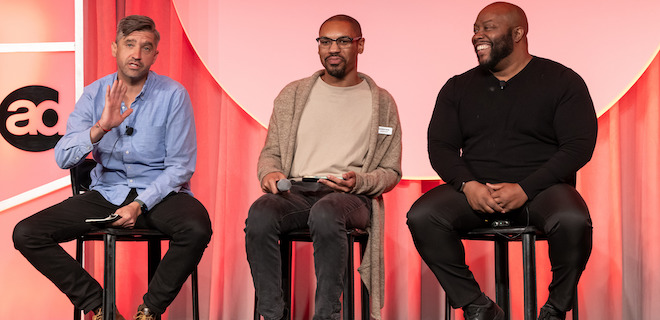
The PubForum Digital Media Smackdown started with some contention between our sell-side and buy-side fighters, but they both agree that each side needs to be more transparent to clean up the complexity in the programmatic supply chain.
On one side of the ring, we had Terry Guyton-Bradley, Senior Director of Advertising Technology at Fortune, representing the sell side. Conversely, Justin Scarborough, AdTech & Programmatic Media Buying Consultant at U of Digital, represented the buy-side.
I got to referee both of these formidable fighters in this highly anticipated programmatic match-up — there were heavy blows from both sides, mentions of cartels, and several rounds of healthy supply chain competition — but the smackdown was not a title fight or a chance at endless glory. They were both duking it out to create a healthy supply chain.
Has there ever been a fight for a more worthy cause?
At PubForum New Orleans, we hosted a session, Digital Media Smackdown: Buy-Side V. Sell-Side Programmatic Data Gap, inspired by an article that argued the industry is supply-side dominated because of information asymmetry. We discussed how sellers and buyers can improve their practices, how the ad tech industry will look with fewer intermediaries, and how to maneuver the complex programmatic supply chain.
Is the Industry Supply-Side Dominated?
According to the initial study, ANA Programmatic Media Supply Chain Transparency Study, publishers tend to have better information about the quality of media inventory sold in auctions. Neither one of our fighters had much contention to this opinion. Guyton-Bradley vehemently agreed that we’re currently in a supply-side dominant industry.
“While collaborating with various tech providers, they prioritize bringing their data onto our platform rather than us sharing our data or data points. It’s already a supply-side scenario,” said Guyton-Bradley.
On the other side, Scarborough asserted that it’s daunting from a buyer’s standpoint, yet it brings a sense of relief. Historically, intermediaries, especially in programmatic and automated trading, have dominated, providing a buffer from direct publisher interactions.
“The challenge lies in our lack of insight into what truly works. We seek meaningful audiences, yet we lack clarity on their performance and market value,” said Scarborough. “The gap persists between my need for scale and willingness to pay and the sell-side’s desire to maximize returns on the audiences you offer. Unfortunately, this middle ground remains elusive.”
The Battle With Intermediaries
From the sell-side perspective, there needs to be a discrepancy between what they want – scale and willingness to pay for it – and what they see in terms of the value you attribute to that information or data.
Intermediaries, the infamous middleman, create complications, requesting desired data at a significantly lower cost than its actual worth, based on Guyton-Bradley’s experience. The effort and price involved in comprehending their audience, gathering and packaging data, and integrating it into the system are substantial. The challenge emerges when a buyer demands an audience at a low cost, whereas the price is significantly higher for them to provide that audience.
In a surprise turn, Scarborough dropped a truth bomb that shook the room: “I’ll reveal a hidden truth: while I might bid $1.25, the platforms I collaborate with push for the lowest CPM possible from you.”
He elaborates further that even if they reveal their margins, which is rare, they manipulate algorithms to decrease bidding, aiming for the lowest clearing price and marking up these savings to sell to buyers. On the other side, buyers are willing to pay more, but intermediaries conceal the actual costs, fostering a misleading perception of savings.
In colloquial terms, shots fired!
Shifting Power Dynamics and Walled Gardens
According to Guyton-Bradley, historically, publishers have been powerless, accepting anything thrown at them without much benefit. He emphasized collaborating more closely with tech providers to create a better alternative to Google’s dominance.
“Collectively, if we had worked together, we would have wielded more power than we do now,” said Guyton-Bradley. “The issue is the segmentation – they hold relationships on the buy side, we hold them on the sell side, and a colossal barrier divides us because we’ve failed to cultivate these connections. Unfortunately, we lack awareness of each other, leading to unanswered calls and emails lost in an abyss.”
Scarborough had two perspectives on this. Firstly, addressing communication: from the buy side, they face the same pressure on margins. Their clients constantly demand reduced agency rates, making it challenging to allocate time for thorough responses or evaluations of intermediaries’ margins and engage more effectively with publisher partners. This side of the scenario is severely broken on the buy side.
“The other aspect is pricing. While many focus on Google’s monopoly, the reality is that both Google and Facebook dominate over 70% of the ad tech market,” said Scarborough. “Media plans rarely exclude them, and their recent colossal earnings demonstrate their control over pricing, resembling the structure of industries like oil controlled by entities like OPEC. They’ve created an opaque market, dictating pricing across the board. To engage buyers effectively, addressing this cartel-like structure is crucial.”
Common Ground
The programmatic supply chain is a complex ecosystem. With many fighters in the ring scrapping for ad spend, audience targeting, and fair CPMs, the industry must find a way to create a sense of common ground and community.
Whether that means cutting out some unnecessary intermediaries, opening transparency on both sides, or knocking down some of these walled gardens, the programmatic supply chain needs a deep cleaning.
To help ease some of the tension in the programmatic supply chain, Scarborough suggests, “I believe the focus should be on automating the essential campaign tasks effectively, such as building, running, and reporting, as well as hosting data warehouses. This prevents us from allowing astronomical margins disguised as automation and performance enhancements. Building deeper relationships with publishers and embracing genuine automation can redirect attention from funneling money into certain systems, creating a more efficient and productive operational landscape.”